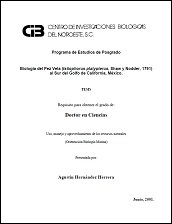Plasma Hypoxanthine-Guanine Phosphoribosyl Transferase Activity in Bottlenose Dolphins Contributes to Avoiding Accumulation of Non-recyclable Purines
Autor
ROBERTO ISAAC LOPEZ CRUZ
RAMON GAXIOLA ROBLES
ORLANDO LUGO LUGO
TANIA ZENTENO SAVIN
Metadatos
Mostrar el registro completo del ítemResumen
"Marine mammals are exposed to ischemia/reperfusion and hypoxia/reoxygenation during diving. During oxygen deprivation, adenosine triphosphate (ATP) breakdown implies purine metabolite accumulation, which in humans is associated with pathological conditions. Purine recycling in seals increases in response to prolonged fasting and ischemia. Concentrations of metabolites and activities of key enzymes in purine metabolism were examined in plasma and red blood cells from bottlenose dolphins (Tursiops truncatus) and humans. Hypoxanthine and inosine monophosphate concentrations were higher in plasma from dolphins than humans. Plasma hypoxanthine-guanine phosphoribosyl transferase (HGPRT) activity in dolphins suggests an elevated purine recycling rate, and a mechanism for avoiding accumulation of non-recyclable purines (xanthine and uric acid). Red blood cell concentrations of hypoxanthine, adenosine diphosphate, ATP and guanosine triphosphate were lower in dolphins than in humans; adenosine monophosphate and nicotinamide adenine dinucleotide concentrations were higher in dolphins. HGPRT activity in red blood cells was higher in humans than in dolphins. The lower concentrations of purine catabolism and recycling by-products in plasma from dolphins could be beneficial in providing substrates for recovery of ATP depleted during diving or vigorous swimming. These results suggest that purine salvage in dolphins could be a mechanism for delivering nucleotide precursors to tissues with high ATP and guanosine triphosphate requirements."
Colecciones
Ítems relacionados
Mostrando ítems relacionados por Título, autor o materia.
-
PROMOCIÓN DEL PERIFITON PARA EL CULTIVO DE CAMARÓN BLANCO: HACIA UNA ACUICULTURA ECOLÓGICA
DOMENICO VOLTOLINA LOBINA; JUAN MANUEL AUDELO NARANJO; MARIA DEL ROSARIO PACHECO MARGES -
Suelo y Erosión
YOLANDA LOURDES MAYA DELGADO


